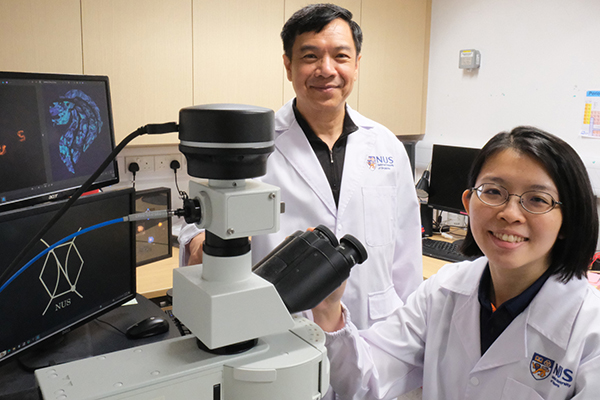29 February 2024
Scientists uncover novel way to create versatile bio-absorbent

Physicists from the National University of Singapore (NUS) have developed a novel method of upcycling fish scale waste into a bio-absorbent that can remove the pollutant Rhodamine B from water, and as a material for to encrypt information.
A research team discovered that heating fish scales to optimal temperatures made them suitable adsorbents for the water pollutant Rhodamine B – a common pink dye used in textiles, paper, paint and water flow monitoring agent. Rhodamine B is associated with potential health risks, such as cancer and liver failure, as well as threats to marine ecosystems, the research team reported.
The scientists also discovered that heat-treated fish scales emit a bright cyan glow, compared to a dim royal blue fluorescence when untreated, under ultraviolet (UV) light. This property can be used to use fish scales as a natural material capable of transmitting micro- and macroscopic text and imagery.
“As the global population grows and resources become more limited, sustainability involves more emphasis on reusing waste materials,” said Professor Sow Chorng Haur from the NUS Department of Physics. “Globally, an estimated 7.2–12 million tons of fish waste is expected to be discarded annually. This makes fish scale waste a rich resource for upcycling. By re-examining waste streams, amazing properties and multifunctionality can be discovered in materials that may have been overlooked before.”

Fish scales are mainly composed of interlacing collagen, a protein known to maintain one’s youth, and hydroxyapatite, a mineral found in bones and teeth. Due to the biocompatibility of these two compounds, various methods have been used to extract them for further development in fluorescence labels that aid in the detection of biomolecules in research. However, these processes often require large amounts of time, energy and chemical resources. Enhancing the fluorescence of fish scales by a more direct and efficient method would improve cost-effectiveness.
Scientists discovered that when they heated fish scales, two things happened. First, the long collagen chains in the scales are broken into smaller pieces that produce blue light when UV light hits them. Second, the arrangement of the atoms changes, creating tiny holes on the surface and inside the scales. These changes made the scales better at absorbing pollutants and changed how they glow under UV light.
When heated fish scales were placed in water with Rhodamine B, they removed 91 percent of the pollutant in just 10 minutes. Also, fish scales contaminated with Rhodamine B can be reused through the sonication process. With only a single step of thermal annealing required, this innovative method is more cost, energy and time efficient than using other cheap biomass such as activated carbon white sugar that has to go through multiple steps of chemical treatment , washing and thermal annealing to remove Rhodamine B.
The fluorescent properties of heat-treated fish scales under different types of light can also be used for steganographic purposes. The scales can be heated en masse on a hotplate and arranged to convey a message, or laser-engraved with text and images on a microscopic scale. These hidden messages can be revealed under UV light. Heat-treated fish scales that adsorbed Rhodamine B also glowed orange under green light excitation, compared to the same fish scales heated without Rhodamine B that showed very dark blue fluorescence at under the same light. This presents another option for steganographic pattern design.
The research team will explore the development of a cost-effective and easily accessible Rhodamine B test kit for use in field detection using heat-treated fish scales. The approach can help reduce the risk of Rhodamine B consumption and exposure by communities that rely on natural water bodies, and outfield scientists who transport contaminated water sources.
Further research will also explore whether heat-treated fish scales can adsorb other toxic chemicals.
Read the full research paper here.
Now that you have reached the end of the article…
… please consider supporting GSA’s mission to promote responsible seafood practices through education, advocacy and third-party assurances. The Protector aims to document the evolution of responsible seafood practices and share the vast knowledge of our extensive network of contributors.
By becoming a member of the Global Seafood Alliance, you ensure that all the pre-competitive work we do continues through member benefits, resources and events. Individual membership costs just $50 a year.
Not a GSA member? Join in.


